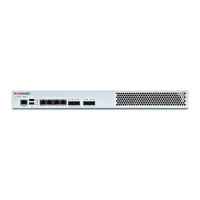How to set up your FortiWAN Configuring Network Interface (Network Setting)
MTU : (Maximum Transmission unit) refers to the size of the largest packet or frame
that a given layer of a communications protocol can pass onwards. It allows
dividing the packet into pieces, each small enough to pass over a single link.
IPv4 Gateway : The IPv4 address of the default gateway. This field is mandatory.
IPv6 Gateway : The IPv6 address of the default gateway. This field is optional. Ignore it for
IPv4 WAN links or configure it for IPv4/IPv6 dual stack WAN links.
Basic Subnet and Static Routing Subnet
As mentioned previously, FortiWAN’s Routing Mode plays the role routing packets between subnets. For applications
deploying different subnets in FortiWAN’s WAN or (and) DMZ, you are required to complete configuration of the
subnets. There are two majore types of subnets for your options to deploy.
IPv4 / IPv6 Basic Subnet
Basic subnets are subnets connected directly to FortiWAN. According to the location a subnet deployed to, Basic
Subnet (See "Scenarios to deploy subnets") is divided into:
l Subnet in WAN: A subnet deployed in WAN.
l Subnet in DMZ: A subnet deployed in DMZ.
l Subnet in WAN and DMZ: A subnet deployed in WAN and DMZ. The subnet that is on the same network segment is
implemented by Proxy ARP.
l Subnet on Localhost (Not support for [IPv6 Basci Subnet])
Among these, [Subnet in WAN and DMZ] is the most general basic subnet for deplyment. You can have multiple basic
subnets for various requirements, such as one subnet in WAN and another subnet in DMZ, or one subnet in WAN and
DMZ and another subnet in DMZ. Note that it is necessary to deploy at least one subnet in WAN or subnet in WAN and
DMZ for a WAN link. you cannot configure a WAN link containing only one basic subnet which is deployed in DMZ. The
field “IP(s) on Localhost” in configuration of Subnet in DMZ is for assigning IP(s) on the DMZ port, not for WAN port. It
requires at least one IP address be assigned to localhost of a WAN port for data transmission via the WAN link, which
means at least one subnet in WAN or one subnet in WAN and DMZ is required in routing mode.
IPv4 / IPv6 Static Routing Subnet
Static routing subnets are the subnets connected indirectly to FortiWAN via a router or an L3 switch (See "Scenarios to
deploy subnets"). According to the location a subnet deployed to, Static Routing Subnet is divided into:
l Subnet in WAN: A static routing subnet deployed in WAN, connected to a basic subnet in WAN or basic subnet in
WAN and DMZ.
l Subnet in DMZ: A static routing subnet deployed in DMZ, connected to a basic subnet in DMZ or basic subnet in
WAN and DMZ.
Next comes a few examples to further illustrate configurations in [Basic Subnet] and [Static Routing Subnet].
37 FortiWAN Handbook
Fortinet Technologies Inc.

